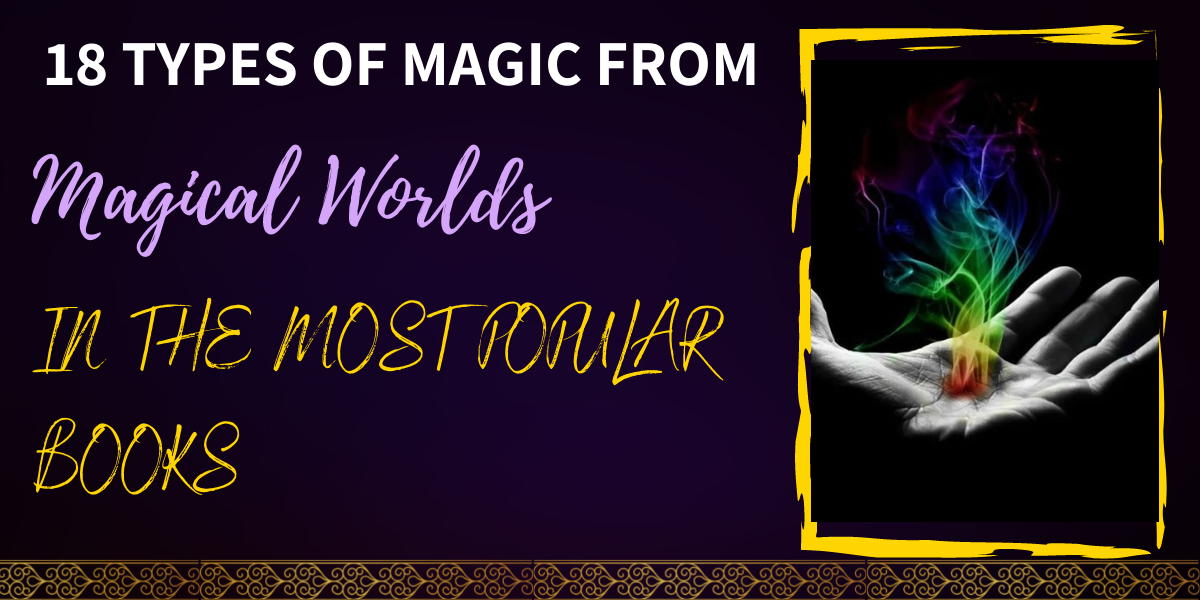Fiction, especially fantasy fiction, is packed full of different types of magic. Some of them are unique to a particular story, but many of them have common features and fixed laws that pop up over and over again in different books.
It’s impossible to list all the different types of magic from the countless magical worlds in popular fiction, but in this A-Z guide, I’ll cover some of the most prevalent ones. I’ll also provide examples of each form of magic and how it’s used in some of the most popular titles from the fantasy, horror, and sci-fi genres.
At a Glance: 18 Types of Magic from Magical Worlds
- The Alchemist
- Stranger with My Face
- Ella Enchanted
- Harry Potter and the Order of the Phoenix
- The Dresden Files
- The Lace Reader
- Vampire Academy
- Garden Spells
- The Black Company
- Lord of the Rings trilogy
- Neverwhere
- Cycle of the Werewolf
- The Locked Tomb
- The Death Gate Cycle
- Belgariad and Mallorean series
- The Hitchhiker’s Guide to the Galaxy
- Anna Dressed in Blood
- Breaking the Wall trilogy
| IMAGE | PRODUCT | FEATURES | PRICE |
|---|---|---|---|
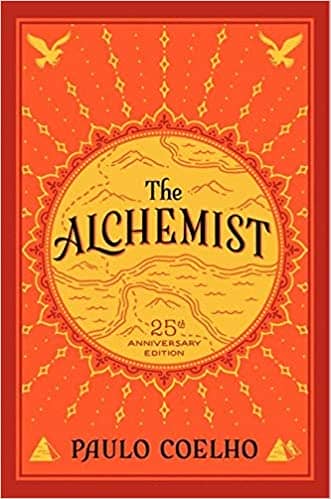 | The Alchemist | • Publication date:April 15, 2014 • Print length:208 pages | |
 | Stranger With My Face | • Publication date:April 19, 2011 • Print length:320 pages | |
 | Ella Enchanted | • Publication date:May 2, 2017 • Print length:240 pages | |
 | Harry Potter and the Order of the Phoenix | • Publication date: January 1, 1961 • Print length:328 pages | |
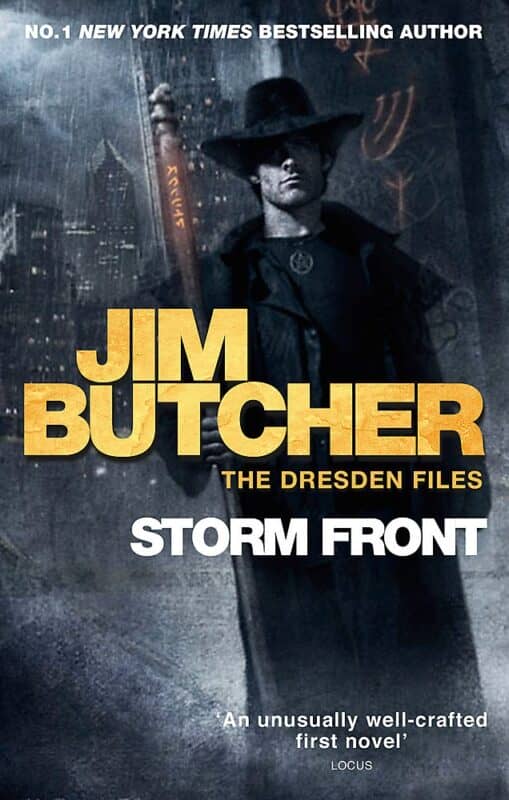 | Dresden Files | • Publication date:April 1, 2000 • Print length:372 pages | |
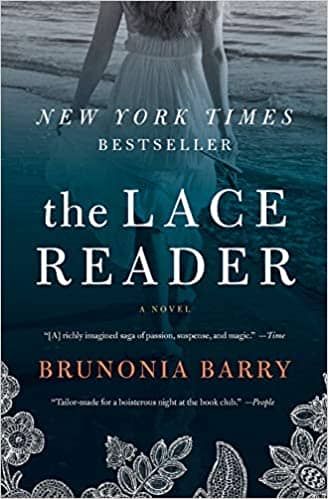 | The Lace Reader | • Publication date-August 18, 2009 • Print length:416 pages | |
 | Vampire Academy | • Publication date-August 23, 2011 • Print length:144 pages | |
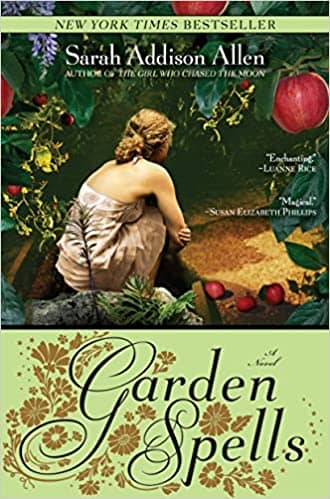 | Garden Spells | • Publication date-April 29, 2008 • Print length:320 pages | |
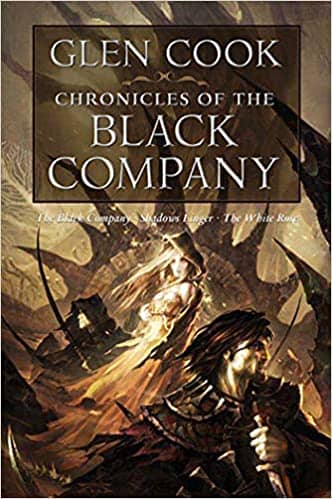 | The Black Company | • Publication date-November 13, 2007 • Print length:704 pages | |
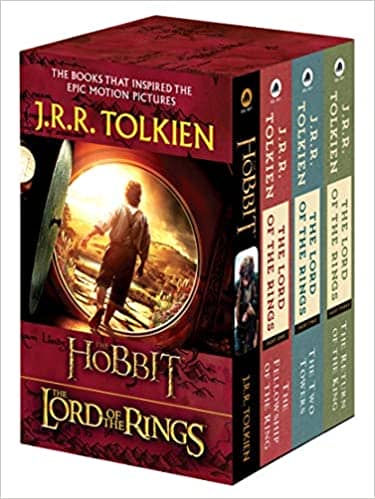 | Lord of the Rings trilogy | • Publication date-September 25, 2012 • Print length:1728 pages | |
 | Neverwhere | • Publication date-January 19, 2021 • Print length:468 pages | |
 | Cycle of the Werewolf | • Publication date-August 13, 2019 • Print length:128 pages | |
 | The Locked Tomb | • Publication date-July 14, 2020 • Print length:496 pages | |
 | The Death Gate Cycle | • Publication date-January 1, 2007 • Print length:448 pages | |
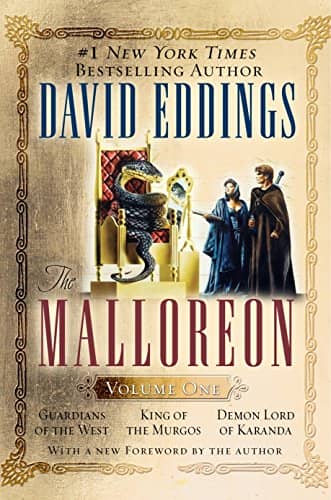 | Belgariad and Mallorean series | • Publication date-August 30, 2005 • Print length:816 pages | |
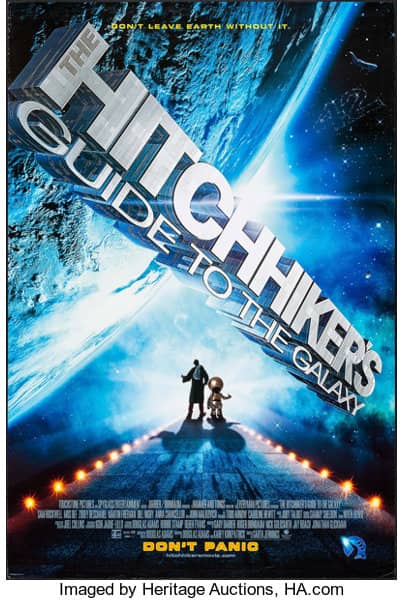 | The Hitchhiker's Guide to the Galaxy | • Publication date-June 23, 1997 • Print length:208 pages | |
 | Anna Dressed in Blood | • Publication date-August 13, 2020 • Print length:320 pages | |
 | Breaking the Wall trilogy | • Publication date-11 February 2020 • Print length:434 pages |
1. Alchemy

Alchemy is the practice of changing a chemical element from one form into another. This seemingly magical process is carried out by an Alchemist. Alchemy has been practiced in various cultures over millennia, and it’s found its way into countless works of literature too.
The most common form of alchemy found in fiction books is the kind that involves transforming low-value base metals into precious and expensive substances like gold.
The most famous example of alchemy in literature is undoubtedly found in Paolo Coello’s bestselling novel, The Alchemist.
The protagonist, a young man, named Santiago, meets the mysterious 200-year-old practitioner of alchemy in a desert oasis. He seems to have magical powers unlike anything Santiago has seen before, and he can tell right away that he’s extremely powerful. He later learns that the alchemist has two magical tools at his disposal; the Philosopher’s Stone, which can turn any metal into gold, along with the Elixir of Life, which cures all disease.
2. Astral Magic

Astral magic is the overriding term for any magic that involves astral projection, astral travel, or the astral plane.
The astral plane is a mysterious realm of thoughts, dreams, and perception. Practitioners of this type of magic can transport themselves to another place and time within the astral realm at will, using the astral plane.
Though it’s a relatively common type of magic in fiction, many people claim to practice astral travel and astral projection in the real world too. It’s described as a kind of out-of-body experience, where the soul becomes free from its physical form and can travel throughout the universe.
In the bestselling young adult horror novel Stranger with My Face by Lois Duncan, the protagonist Laurie Stratton becomes a victim of dark astral magic after her long-lost twin sister Lia begins visiting her town through the astral plane. Lia is able to leave her physical incarnation and send her soul anywhere she chooses. Eventually, she even manages to enter and control her sister’s body using astral projection.
3. Binding Magic

Binding magic covers a broad category of magic which involves casting spells that prevent a person from doing something, e.g., binding them up. Its roots go back to the ancient Greeks and Romans, who used binding spells with specific words and formulas that had to be said correctly for the magic to work.
Though most examples of binding magic in literature tend to be in the form of curses, it isn’t always used for evil; it can also be used to prevent someone from hurting themselves or other people too.
In fact, legend has it that In 1940, a group of British witches performed a binding spell to prevent Adolf Hitler from invading England. The Nazis never did manage to occupy the country, but whether that’s down to military strategy or more magical means is still up for debate.
In Gail Carson Levine’s popular series Ella Enchanted, the main character is the victim of a binding spell. When she was born, a well-meaning young fairy named Lucinda gives her the “gift” of obedience, but her gift turns out to be a curse. Any time someone tells her what to do, she has no option but to obey them.
As she gets older, her curse becomes a torment, and so she sets out on an epic mission to track down Lucida and reverse the binding spell so she can finally be free.
4. Conjuration

Conjuration, or conjuring, involves summoning spirits, demons, gods, objects, or energy into the earthly realm through the forces of magic. Conjuration magic can also be used in reverse too, to send these entities into other realms or planes of existence. And although it seems like they’ve disappeared completely, they’ve only moved position.
Conjuring is often associated with black magic and wicked intent, but it can be used for good too.
There are countless examples of conjuration in fiction, and this style of magic frequently appears throughout JK Rowling’s Harry Potter series. In the fifth book, Harry Potter and the Order of the Phoenix, Professor Minerva McGonagall introduces her fifth-year Transfiguration students to Conjuring Spells, including the notorious Vanishing Spell.
5. Dark Arts

The Dark Arts are also often referred to as Dark Magic or Black Magic. These blanket terms cover pretty much any form of magic used to inflict harm on a victim, either through physical injury, mental distress, or even death
Many types of magic fall under this category, including some on this list, but it deserves its own entry since it’s such a popular plot device in fiction.
Jim Butcher’s smash hit fantasy series, The Dresden Files, is packed with dark arts and black magic themes. In the first book, Storm Front, a private investigator of the paranormal, Harry Dresden, is called in to help the Chicago P.D solve a grisly double murder case. The perpetrator uses black magic to commit his horrifying crimes, and it’s up to Harry to put an end to his reign of terror.
6. Divination

Divination means “to be inspired by a god,” but in all practical and historical senses, divination is simply acquiring knowledge by spiritual or supernatural means.
Divination is one of the most common forms of magic, not just in fiction but in the real world. Tea reading, tarot, mediumship, palm reading, and fortune telling are all popular methods of divination throughout much of the world, even today. Historically, the prophets from some of the world’s major religions, such as Christianity, Islam, and
Judaism was all practicing divination; they received their knowledge about the past, present, and future directions from god and shared it with the people.
In Brunonia Barry’s bestselling novel The Lace Reader, the protagonist practices divination from her home in Salem Maasachessets by reading the intricate patterns in lace. Towner Whitney and the rest of the females in her family are all skilled lace readers, and they can see into the future with incredible accuracy.
But her gift is also a curse. At just 15 years old, Towner predicted and witnessed an event so horrifying that she ran away from her home and her family and vowed never to read lace ever again.
7. Elemental Magic

Elemental magic, also called elemental manipulation, involves harnessing the elements such as Earth, air, fire, and water, to produce magical results. Practitioners can use the energy these elements create to cast spells that have powerful effects in the real world.
Elemental magic can also be used to manipulate and control the elements themselves, for example, to create floods or catastrophic fires.
The Moroi characters in Richelle Mead’s bestselling series, Vampire Academy, are all skilled in elemental magic. These mortal vampires can control and manipulate the elements of Earth, air, fire, water, and spirit at their will, although it takes years of practice to truly master the craft.
Most of the Moroi, including Moroi princess Lissa Dragomir, specialize in one particular element. Lissa’s is spirit, a long-forgotten element that has been abandoned by most of her kind. She uses her powers to save her best friend Rose Hathaway from certain death following a catastrophic car accident.
8. Herbalism

The term ‘herbalism’ can describe a type of alternative medicine that uses the healing properties of plants, but herbalism has a magical side too. When used in combination with each other, herbs and other plants have long been believed to have magical properties that go way beyond the earthly realm.
The idea of herbalism as a type of magic has been around for millennia in cultures worldwide. Even today, the Neo-Pagan community often uses plants in modern-day witchcraft to cast healing spells.
Garden Spells, the first book in Sarah Addison Allen’s popular Waverly Farm series, centers around the theme of magical herbalism. Claire Waverly and her family live in Bascom, North Carolina, where their peculiar garden draws a lot of attention from their neighbors.
Packed full of magical plants and flowers, and even an apple tree whose fruit tells the future, the Waverly’s garden is a mystical place where anything is possible. The pansies have the power to make children more thoughtful, the nasturtiums help the loose-lipped keep a secret, and the snapdragons keep away unwanted attention from the neighbors.
9. Illusionary Magic

Anyone can create an illusion with the right tools and the know-how, but only those with magical powers can practice the art of illusionary magic. Illusionary magic is all about making something appear a certain way, even though it isn’t, through the use of real magic.
This type of magic is often performed with spells. One of the most common forms of illusionary magic is the power to make something disappear, but the object isn’t really gone; it just seems that way thanks to a little supernatural help.
The Black Company by Glen Cooks features a group of wizards; TomTom, Goblin, Silent, and One-Eye, who often use illusionary spells in very creative ways. For example, One-Eye saves the lives of many of his Company brothers by distracting their enemies with terrifying illusions during combat. He also manages to extract valuable information from a captured assassin by using illusions so powerful that they eventually kill him.
10. Immortality

Immortality is one of the most well-known forms of magic in all of fiction. The idea of living forever is appealing to some and terrifying to others, but whichever camp you sit in, immortality is a fascinating concept.
Themes of immortality are found in all kinds of popular fantasy and science fiction books. For example, JRR Tolkien’s epic Lord of the Rings trilogy features a whole host of immortal characters. In fact, the author himself stated in his letters that the primary theme of the books is death and our universal desire to escape it, so it makes sense that he bestowed the gift of immortality on so many of his characters.
“But I should say if asked, the tale is not really about Power and Dominion: that only sets the wheels going; it is about death and the desire for deathlessness. Which is hardly more than to say it is a tale written by a Man!” …JRR Tolkein
In all three books, every being from the land of Arda, such as the Ainur and the Elves, are immortal. But some choose to give it up, like the elf Arwen, who sacrifices her eternal life in order to marry her mortal lover Aragon.
He eventually dies at the impressive age of 200, leaving Arwen behind. Now a mortal, she travels to the ruins of Lothlórien, where her most treasured memories lie, to die a lonely death beside the river Nimrodel
11. Invisibility

Invisibility is a common plot device found in fantasy, science fiction, horror, and mystery novels. When invisibility is linked to magic, it’s often invoked by a physical object, such as a cloak, a ring, or a hat. It’s also sometimes brought about by casting a spell.
There are countless popular books that feature invisibility, and it can a powerful tool used for both good or evil. Often this magical power can be used to escape danger and get one over on enemies, but other times, it’s a curse.
Neil Gaiman’s novel Neverwhere, the companion novel to the TV series of the same name, tells the story of Richard
Mayhew, a businessman with a seemingly normal life who becomes embroiled in a supernatural assassination attempt. A bizarre series of events leaves him completely invisible to those around him. No one seems to recognize him, not even his girlfriend, and his life begins to fall apart. He loses his job and returns home to find his apartment rented out to strangers.
In desperation, he heads down into the dark and mysterious world of London Below to search for a cure to his predicament, where he finally meets someone who can see him
12. Lunar Magic

The belief in lunar magic, magic associated with the power of the moon, is found in cultures around the world and throughout history. Wicca and other Pagan belief systems practice rituals on certain days in the lunar calendar, especially during a full moon.
In ancient Greek and Roman literature, witches were often accused of “drawing down the moon” by casting spells.
They supposedly harnessed their magical powers through the light of the moon and used it to place curses on unsuspecting victims.
In fiction, the most common type of lunar magic is the transformation of humans into werewolves during a full moon. Countless books, movies, and TV shows feature werewolves with a magical and terrifying connection to the moon.
Cycle of the Werewolf, a novel by the master of horror, Stephen King, is about a hideous beast that emerges one night every month under the eerie light of a full moon. The monster tears through the sleepy New England town of Tarker Mills, and no one is safe. The only thing the townspeople can be sure of is when the full moon rises, death and destruction await
13. Necromancy

Necromancy is a subset of magic that involves communicating with or raising the dead. It can be used for divination, for example, how a medium communicates with the sous of the deceased to pass messages onto their loved ones. Necromancy can also take the form of conjuring by summoning spirits, ghosts, and apparitions of the dead.
Zombies are also a classic example of necromancy, but in most cases in fiction, the walking dead haven’t been unearthed from their graves using a magic spell.
When portrayed in literature, this super spooky form of magic is usually framed as evil and frightening. Necromancy is a major theme in Tamsyn Muir’s recent science fantasy series, The Locked Tomb, which takes place in an intergalactic empire split into nine planets. Each planet practices a unique type of necromancy, and they use it to defend their land and defeat their enemies.
14. Rune Magic

Rune magic is a type of Norse and Viking magic that has been practiced since ancient times. Rune magic has its own alphabet, and each letter has a unique symbol and a name that represents a metaphysical concept. Together, these letters can be combined to cast spells, either through runestones, inscribing them on solid material, such as rock, or speaking them out loud.
The Death Gate Cycle fantasy series by Margaret Weis and Tracy Hickman features many elements from the rune tradition. Set in ancient Arianus, the Realm of the Sky, humans, dwarves, and elves battle it out for domination using their own unique versions of rune magic.
15. Shapeshifting

Shapeshifting is also often called metamorphosis. Shapeshifters can change their form at will, but there are many different types of shapeshifting magic. Some shapeshifters have the power to transform themselves into an animal, or an object, or even an element, like water. Others can take on the form of anything they touch. And some very powerful shapeshifters can take on any incarnation they wish, at any time.
In the bestselling Belgariad and Mallorean series by David and Leigh Eddings, shapeshifting is a common theme. Shapeshifters appear in all thirteen books, but one of the most memorable is the title character in Polgara the Sorceress. Polgara is the only woman in a powerful brotherhood of sorcerers, and she can hold her own against any of her magical male counterparts. Throughout the story, she takes on all kinds of forms, from a snowy white owl to a child, to the most powerful politician in the world.
16. Teleportation

Teleportation is the ability to transfer matter or energy from one place to another in an instant. It’s one of the superpowers that many of us wish we had, and according to science, it might actually be possible in the future, thanks to some mind-blowing discoveries in metaphysics. But for now, the closest we’re going to get to teleportation is through science fiction and fantasy books, movies, video games, and TV.
The magic of teleportation has been used as a plot device in all kinds of stories, including Douglas Adams’s classic, The Hitchhiker’s Guide to the Galaxy. Throughout the novel, it’s a common occurrence, thanks to the Infinite Improbably Drive, which allows spacecraft to teleport anywhere in-universe. But it’s generally seen as a pretty risky and unpleasant business, so much so that there’s even a song, the “Teleportation Blues,” which features the line “They’ll do anything you like, Real fast and then real slow, But if you have to take me apart to get me there, Then I don’t want to go.”
17. Voodoo

Voodoo is a real-world religion that is still practiced in various countries around the globe today. It’s a combination of Roman Catholic and African tribal traditions, which center around serving the spirits and gods through devotional rituals in order to receive blessings.
Voodoo is often misunderstood. Yes, it sometimes involves things like animal sacrifices and spirit possession, but it’s not an inherently evil practice. In fact, in many cases, Voodoo is used to help people.
But the Voodoo magic we see in books is usually a fictionalized version portrayed as dark and sinister, often involving wicked curses using voodoo dolls and other effigies. The bestselling YA novel Anna Dressed in Blood by Kendare Blake combines horror and paranormal fantasy to tell a terrifying tale drenched in West Indian voodoo tradition. The evil Obeahman stalks and curses his victims with a powerful form of Voodoo called Obeah.
18. Zodiac Magic

Zodiac magic comes in various forms and can wield its power from any of the zodiac traditions. It often involves casting spells for specific horoscope signs, harnessing the power of particular zodiac creatures, or channeling magical energies at certain times during the zodiac calendar.
The Breaking the Wall trilogy by Jane Lindskold is an urban fantasy series that intertwines spellbinding magic with the ancient Chinese Zodiac. In the first book, Thirteen Orphans, protagonist Brenda Morris’s world is turned upside down when she discovers that her father is a member of a group of mystical orphans who were exiled to Earth after a cataclysmic battle. Each of the Thirteen Orphans represents a particular animal from the Chinese Zodiac, and the magical powers of these animals are passed down from generation to generation.
Now, after years of enemy attack, only a few orphans survive; The Rooster, the Tiger, the Dog, the Rabbit, and Brenda’s father, the Rat. Brenda must follow her birthright and use the magic of the Zodiac to defeat these enemies once and for all.
Conclusion
I’ve tried to include all of the most common types of magic from the magical worlds of fantasy, sci-fi, and horror in this A-Z guide, but it’s impossible to list them all. Can you think of any that I’ve missed? Drop me a comment in the box below and let me know your favorite types of magic and which books we can find them in.
And if you’re still hungry for more magic-based trivia, check out my A-Z guide of Magical Beings and Their Definitions.



